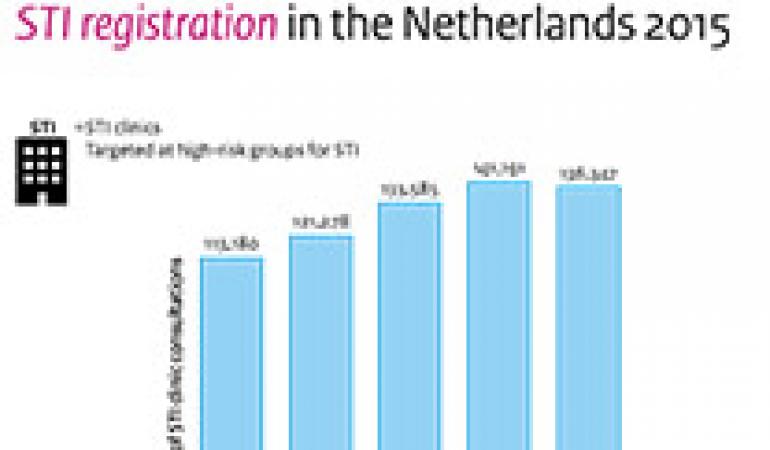
The number of people who were tested for a Sexually Transmitted Infection (STI) at a Dutch STI clinic has dropped for the first time in years. The percentage of people diagnosed with an STI increased to 17.2 per cent. Chlamydia continues to be the most prevalent STI. This emerges from the RIVM report ‘Sexually Transmitted Infections in the Netherlands in 2015’.
The total number of STI clinic consultations in 2015 was 136,347, a drop of 3.4 per cent compared to 2014. The decrease in consultations is a result of the financial restrictions introduced in 2015 of the “additional regulation for sexual health” (ASG), ‘freezing’ the number of visitors per STI clinic and limiting the number of tests performed, causing a stricter triage at the STI clinics. The number of GP consultations also seems to decline, but the most recent data is from 2014. See also our infographic.
High-risk groups
STI clinics offer free STI tests for high-risk groups. The majority of STIs concerned people who had been warned of possible STI exposure by their (former) partner, people with STI-related complaints, and HIV positive men who have sex with men (MSM). Young adults under 20 years of age with low-level qualifications and people who visit an STI clinic a second time in the same year are diagnosed with STIs more frequently.
Chlamydia
In 2015, 13.7 per cent of STI clinic attendees had a chlamydia infection (18,585 diagnoses). This figure represents an increase of 1.1 per cent compared to 2014. The biggest increase was seen in heterosexual men (up from 13.9 per cent in 2014 to 16.1 per cent in 2015). Chlamydia was diagnosed most frequently in women and heterosexual men under 20 years of age (21.0 per cent) and in people who had been warned about potential exposure (34.0 per cent). The percentage of MSM diagnosed with chlamydia has been stable for years at around 10 per cent.
Gonorrhoea
The number of gonorrhoea diagnoses increased by 17 per cent to 5,391 diagnoses. This STI is more frequently seen in MSM (10.7 per cent), while the percentage in women and heterosexual men remained stable (1.6 and 1.9 per cent, respectively). One in five gonorrhoea cases was diagnosed following a warning from a partner. To date, no gonorrhoea infections have been found with resistance against first-line antibiotics in the Netherlands. Less than half of the samples testing positive were also tested resistance, a drop compared to previous years.
Syphilis
In 2015, the number of syphilis diagnoses increased by 27 per cent to 942, even though fewer young adults under 25 years of age were tested due to changed testing policies. The percentage of MSM with a syphilis infection increased further, from 2.3 per cent in 2014 to 2.6 per cent in 2015. The past year once again saw a strong increase of syphilis cases in known HIV-positive MSM: up from 6.6 per cent in 2014 to 8.0 per cent in 2015. Of all MSM with syphilis, 22 per cent had been warned about it and 40 per cent were known HIV-positive.
HIV
In 2015, the number of people newly diagnosed with HIV at STI clinics decreased by 11 per cent (from 323 cases in 2014 to 288 in 2015). MSM accounted for nearly 90 per cent of this group. The percentage of new HIV diagnoses in MSM declined from 3.0 per cent in 2008 to 0.9 percent in 2015. The number of HIV patients newly registered at Dutch HIV treatment centres also dropped, from 1,311 in 2008 to 1,033 in 2014.
Genital warts and genital herpes
In 2015, the number of genital warts and genital herpes diagnosed at STI clinics in the Netherlands was respectively 2,000 and 428 (numbers in 2014: 2,029 and 479). By far the largest part of these STIs were diagnosed at the GP. In 2014 an estimated 37.800 patients with genital warts and 22.000 patients with genital herpes were diagnosed at the GP. Genital warts were diagnosed more often among men than women (55 per cent versus 45 per cent), while genital herpes was diagnosed more often among women (73 per cent).